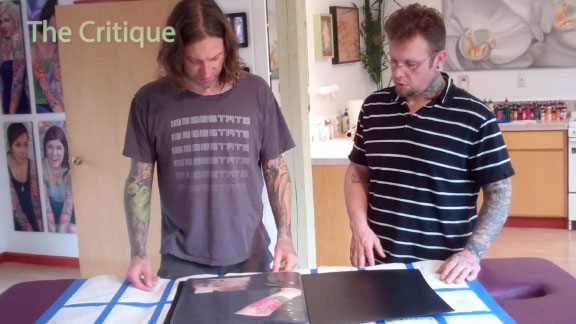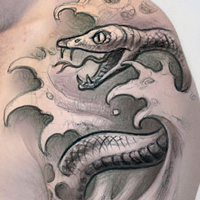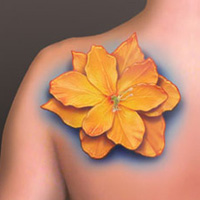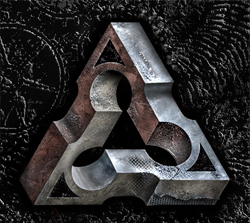Welcome to my column, Ask Guy, where I'm responding to questions from both artists and collectors. Since this column is available to the general public, I won't be answering any questions about nuts-and-bolts technical matters. Instead, I've found that most questions about doing better tattoos can be addressed with discussion of design, such as color theory or contrast, and that understanding these ideas can be helpful for both artists and collectors. Other tattoo related subjects are welcome too. Go ahead and hit me up at this contact link to submit a question.
A version of this column can also be found monthly in Tattoo Magazine.
Lines and Edges: A Critique Example
The tattoo that I'm critiquing for the Lines & Edges example is by Cecelia, who was asked by her client to do a "Mother Nature" type piece that represents the progression of life and death. It's the type of illustrative tattoo that can contain a lot of elements and possibly become cluttered and hard to read if care isn'…

Greetings, and welcome to another Ask Guy critique column, where I'm hoping that by doing honest, constructive critiques of other artists' work I can hel…
Welcome to this month's edition of Ask Guy, where I've been taking your most challenging questions over the past several years, and trying to make sense of them. For this past year the column has been focused mainly on critiquing, since that seems to be a great way to demonstrate exactly what an artist could do t…
This month I'm taking a look at the work of Colin Byrne of DC Tattoos in Ireland, who aims to be a versatile artist who can work proficiently in many styles. Colin has been a client of mine for several years and we've had a chance to go over his work before, so he's already doing a lot of things that …
This month I'm critiquing Oliver Wong, who works in the Bay Area but has apprenticed in part with the great Just Shao of Shanghai, China. I recently had a chance to do a collaborative tattoo project with Just and was blown away by his skills and vision. His style is a fusion of realism and a stylized graphic …
I'm always excited to do a critique, since there's generally such a positive response from everyone. I'm especially grateful to the individuals who are willing to come forward and have their work critiqued publicly, such as in these columns, which are circulated to more people than any other tattoo magazine i…
Critiques are a long-standing tradition among artists, especially in academic settings. Outside the classroom it's sometimes hard to get an honest critique aimed at helping rather than tearing down. It's always exciting to see tattoo studios that have critique nights and that kind of thing, since face-to-face cri…
Many of you have been asking about collaborations, since multiple artist tattooing has become a popular and successful experience for many tattooers. There have been a lot of high-profile collaborative projects published recently in many different styles, and there is even an event, Two Of A Kind, that is structu…
Welcome to the latest installment of Ask Guy, where I'm taking questions from both artists and collectors about all questions relating to the tattoo art form. I'm hoping that with my 26 years in the industry I can help shed some light on some of your trickiest questions. This year I'm mainly focusing on criti…
The work we're looking at today is by Mason of Blue Tattoo Cafe in San Diego, CA. He says: "Being a self taught artist of three years and a shop owner, I never pass on the opportunity to have another artist critique my work. I really appreciate you taking the time to read me email. Its hard in my position to progress my art and find other ar…
This month I'm taking a look at work by Rusty Dornhecker of Red Tree Gallery in Columbus, Ohio. Rusty was a tattooist around 20 years ago, but (he feels) under the wrong circumstances and the wrong teachers. So for a period he had quit tattooing and pursued oth…

This month's submissions are from Lee Pickles of Spektra Tattoo in the UK. Lee sent a variety of pieces in a number of different styles, including biomech, rea…
For any of you reading this who have teenagers in the house, show them this article. It's never too early to have The Talk with them about avoiding bad tattoos, because the reality is, they just don't know any better.
A, Hey Robert, thanks for asking- I've been waiting for someone to ask, as it's one of my favorite subjects. And you are right, I've heard a few horror stories, but all the really good collaborations I've seen (or been involved in) have a few …
A: Dale, I commend you on wanting to do your research more thoroughly. You are right that this could help you make better decisions about your collection in the future. However, by wanting to know such specific things about tattoo design principles, you sort of enter a gray area where much of the educational material that's been pr…
Q, from Nicole: I need some tips on how to get into tattooing. I'm creative, have a steady hand and some drawing talent, and have been honing my painting skills over the past yea…
A: This is one of the fundamental challenges in building a tattoo career, and the answer isn't a simple one, but instead consists of a whole new approach to your career and your relationship with your clients. Remember that trust is crucial to the tattooi…
A: There are some clients that are more prone to keloid scarring, particularly darker skinned collectors. But even in those cases, you usually won’t get much raising of the skin if the tattoo is done carefully. Raised or scarred lines are unfortunately …
A: This is actually a subject that is sort of near and dear to me, since I am a heavily acne-scarred individual, your classic pineapple face. I really got it the worst on my neck and back, but there were deep infections in my chest and other place…
Welcome to my column! I've had some interesting feedback so far, but if anything stands out it seems that a lot of people, both artists and collectors, are curious about coverup work. With such radical improvement happening in the quality of…
A: Well, for …

The thing is, I can't think of a way to use less stuff, because it's kind of like a complete idea. It's for my grandmother Diana, who was a very strong woman and a big influence on me. She identified with the Roman goddess Diana, who carries a bow and usually has a deer with her, showing her righteous nature... I'd li…

A) A lot of the rules that apply to black and gray design also apply to color. Really, it's about good tattoo design, period, with a few crucial differences. It's so simple and so complicated at the same time- I'll try to work on the simple part first:
1. Make your shapes big enough so they use the space effectively

A) I actually use a number of different brands, and if you look at some of my older blogs at www.tattooeducation.com, these brands are listed. But I have to say here that the brand of pigment you use is far less important than the artist's understanding of color use. It's perfectly understandable to assume that some technical detail,…
A) Excellent question my friend! There's an elephant in the tattoo shop here, and its name is Homophobia. And of course this isn't just a tattoo thing... but tattooing is a relatively macho industry, so you'll see perhaps a bit more of it than elsewhere. You're basically experiencing the same thing that women went through a…
A) To get really specific, I'd need to see a picture of your work to really know what it needs. But here are some good general guidelines for keeping it smooth:
1) Spread magnums! If you are trying to get smooth shading with round shaders or stacked mags, the odds are stacked against you. Spread mags are ideal because they…
A) It sounds like the solid areas might be just a little overworked. Sometimes you can work the skin a little past its limit but it won't necessarily show when it's fresh unless you go far enough to actually trench or chew up the skin. When surrounded by other fresh swollen work, it won't necessarily look overworked. If your he…
Could you advise me what gray systems you use and what you mix them with?
A) The answer is deceptively simple- use more water! The more diluted the ink, the lighter the gray. Simple as that.
A number of pigment manufacturers are now marketing graywash kits with a range of dilutions... Silverback w…
Q) I'm having a real problem with blowing people out, left and right... any advice?
A) Blowing people out... Outlines you mean? This can be mediated a few ways, all in combination with each other:
1) Tight stretch, always! Nothing else can go right otherwise.
2) You should have plenty of needle extension- at least 1/8" with the armature bar in the down position.
3) Using a combination of ti…
A) I guess my first question would be, what needle group are you using for packing in the black? You'll most likely have the smoothest results with spread magnums- 7 or 13, depending on the size of the piece. Rounds or stacked mags may seem like they would pack the black better because the needles are closer together, but in reality th…
Q) I have a question about clientele approach...
I work in a (custom) street shop where most of our clients want to get tattooed the same day or shortly after. I find this suffocating and wish I had more time to research their art and play with different ideas and mediums before their appointment. I'm criticized by my coworkers for being emotionally vested i…
A) This is usually due to one of two reasons- too much needle, too slow of a stroke cycle (not enough pokes per minute). You are working faster than your machine can keep up, so it hangs up. Sometimes it's as simple as turning up your power a hair, but usually it takes a bit more than that. For lining you are looking for a shorter (the…
A) Most likely it's not the pigments- these days most tattoo pigments are capable of looking bright and rich in the skin if applied correctly. So your saturation is going to be affected by either your machines or your technique. You need a good machine with a long stroke, opposite of a liner. it should have minimal spring tension- not&…
A) That's the big question, isn't it? I'd like to start out by pointing out that tattooing is an amazing career to have- especially when approached the right way. If you end up with poor skills in a crappy shop, it can be a fairly bleak way to make a living, so you need to start out right. That said, I'd like to lay it on t…
A) Pigment reactions are always a shock and a disappointment to both artist and client. When something like this happens, the first (and most important) thing is to determine that it is in fact a pigment reaction and not an infection. Infections are more common than pigment reactions, so first look for the telltale signs: Swollen and irrit…
A) Well, if you are looking to find an answer that creates the least disruption for your family, going off to art school probably isn't the solution unless there is a good school nearby that you can fit into your existing lifestyle. That being the case, look through their catalog and see what classes you think would help the most. Some…
A) Trembling hands are a sign of underdeveloped muscle control. Here's a question for you: How much time do you spend drawing and working in other mediums besides tattooing? If the answer is "a lot", then maybe you could focus on working with your art tools in a way that is similar to tattooing. Try putting larger grips on yo…
A) When you tattoo light pigments over dark ones, they will eventually all settle into the same layer of skin, so what you get is a pigment mix. You aren't actually putting a layer on top of an older, deeper layer, but mixing new pigments with the existing ones. White will lighten black by about 8-12% on the first pass, an additional 6…
(This question was followed by a long phone conversation where I found out: (1) the clients were brothers, (2) one of them has dogs, (3) the one with the dogs has a new baby in the house and has been getting a lot of help with the dogs from his brother)
A) I generally discourage a "blame the client" approach to heali…
A) For a long time, our industry was reluctant to take on disposables, and many artists used them only for travel. One of the big changes that's happening now is that you will find completely legitimate tattoo shops with no autoclave. Many shops are switching to disposables as a way of eliminating the need for a scrub room and the no-f…
A) It's true that as we get older, our skin changes, but only in the cases of severely sun-damaged skin do we not recommend tattooing it. I can understand why a tattooist in the islands might feel a certain frustration when working on sun damaged skin, since it's common for clients to walk in off the beach with a sunburn with the i…
A) The wrist is a tricky area to put detail into, but you shouldn't be afraid to work it. Since you are wanting to slow down for precision purposes, try turning your power down as low as you can get away with; tattoo for a minute, wipe, then see if you need to add more power. Some parts of the body- the wrist and inner bicep are good e…
A) If you are experiencing a snagging sensation, the first thing to try is more power; this may help you to find and work with the machine's natural rhythm. This kind of snagging is relatively rare in coil machines, and is much more common with rotaries- if you are using a rotary machine and dealing with lots of snagging problems that …
A) I've been using Sharpie markers for a long time, along with many other tattooists, and have found them to do well with their longevity during the tattoo process. I like them for several other reasons as well: they come in a wide array of non-toxic colors, and they can be used to blend already dried color on the skin, almost like usi…
A) Layering color this way is actually a good way to prevent trauma, since you can run your equipment with way less force than if you are trying to pack it in solid with one pass. That's the first important point- when layering, you don't want each pass to saturate the skin. Try to keep in mind roughly how many passes of different co…
A) This is a simple question with a complex answer. I have used a variety of power supplies through the years, including a few with digital readouts such as the Eikon power supply and the all-digital unit being marketed by Critical. These are both good solid pieces of equipment that have proven themselves in our studio, but I have gone back …
A) That's a big question. Where to begin? First, what is your artistic experience? and I mean real experience, spending long hours making your art. Without some kind of artistic experience, there's not much you can do. The next suggestion I'd have is to gather together your best art examples into a portfolio, then spend a few d…
A) These kind of areas can be especially tricky in tattoos that span over several skin types, where part of the piece is on tough skin and part is on delicate skin. The thing to do in a case like this is to outline the whole piece, making sure to turn down the machine when working the sensitive zones, and then work the piece to completion or…
A) It's a long A, like when you pronounce the name of the letter H. It gets spelled a zillion different ways too... the most common ways are Atchison, Atchinson, Atkinson, Acherson, Ackerson, Atchesen, Achison and Acherson. But please feel free to pronounce it any way you want.
…






















